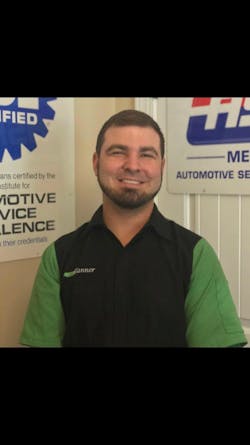Given the technology found in today’s vehicles, a technician’s diagnostic approach needs to constantly adapt to be efficient and precise. For years technicians relied on mechanical tools and a good hypothesis to diagnose problem vehicles, but today diagnostic technicians rely on high tech tools like digital oscilloscopes, pressure transducers and diagnostic scan tools to fix complex problems.
Technological advancements in digital imaging equipment have made their way into the automotive industry, redefining and expanding the tool and skills that mechanics need to efficiently perform their duties. Tools like articulating borescopes, microscopes and thermal cameras have become valuable diagnostic tools in the bay. Borescopes can be used for engine mechanical diagnostics, to check evaporator cores for leaks, or to help find wiring problems in hard-to-reach areas without disassembly. Microscopes can be used to disassemble and reassemble small components, find bad solder joints, or replace components on circuit boards. Thermal cameras can be used to find the source of a parasitic draw or diagnose cooling system, HVAC, and engine drivability problems.
Incorporating these tools into your everyday routine will save you time and money if you know how to get the most out of them. Imagine you have a vehicle with a constant misfire; there is a P0300 code stored and misfires showing on multiple cylinders in mode 6, but nothing that points to only one cylinder. The vehicle has a V6 engine and the rear spark plugs and injectors are under the plenum.
The scan tool you have has no way to disable individual cylinders. What is an easy way to find the problem cylinder? You could let the vehicle cool and then pull out your thermal imaging camera to look at the exhaust ports of each cylinder on the manifolds when the vehicle first starts. Then you could identify which port is cooler than the others; this will be your misfiring cylinder. It’s best to do this when cold otherwise the temperature may be out of range for the thermal camera.
Finally, you notice the culprit is the middle cylinder on the back bank. Of course, it is right? It’s never the easy one! At this point you need to decide whether the problem is mechanical or electrical. You set up your oscilloscope and do a relative compression test and immediately see that cylinder has lower compression than the others. You quickly confirm the coil and injector are good by checking at their respective fuses with your scope. At this point it’s time to remove the intake and find out why that cylinder has low compression. Once the spark plug is removed it only takes a few seconds to look in the cylinder with a borescope. An articulating borescope will allow you to look up at the valves and see them clearly. You notice a piece is missing from one of the valves. At this point you’re done—no need to go any further. If you want to really wow the customer, use a borescope to capture the image, which may help sell the job.
Now imagine you have a collector car that has a single cylinder misfire. You start your diagnoses by finding the misfiring cylinder using scan data. You find the culprit is cylinder number 2. Now that you know which cylinder to chase, you check injector and ignition coil operation using an oscilloscope. You find the misfire is caused by the coil not being fired for number 2. You go to the pcm and confirm the driver inside is not turning that coil on. After checking all your powers and grounds, you condemn the pcm. After calling all your suppliers you find that the pcm you need is no longer available anywhere.
You have good soldering skills, so you decide to remove the pcm and open it up to inspect. You inspect all the components and solder joints under a digital microscope and find the mosfet transistor used to turn on the coil for that cylinder has melted. The microscope you have can move up out of the way while keeping a good clear image on the digital display. This makes unsoldering that transistor and replacing it an easy task.
After the repair is completed you install the pcm and the misfire is gone. You got your customer’s collector car back on the road. Not many other shops could have done that … way to go!
Every day there are new advancements in technology. It’s up to us as technicians and diagnosticians to figure out how to use those advancements to our advantage, not only to benefit our everyday routine, but to advance our field as a whole. If we don’t open our minds to learning new ways to solve problems, this industry and its technology will pass us by.
To the next generation, it’s up to you to make the decision to continue to learn and grow. The digital tools of tomorrow are now in your hands!


